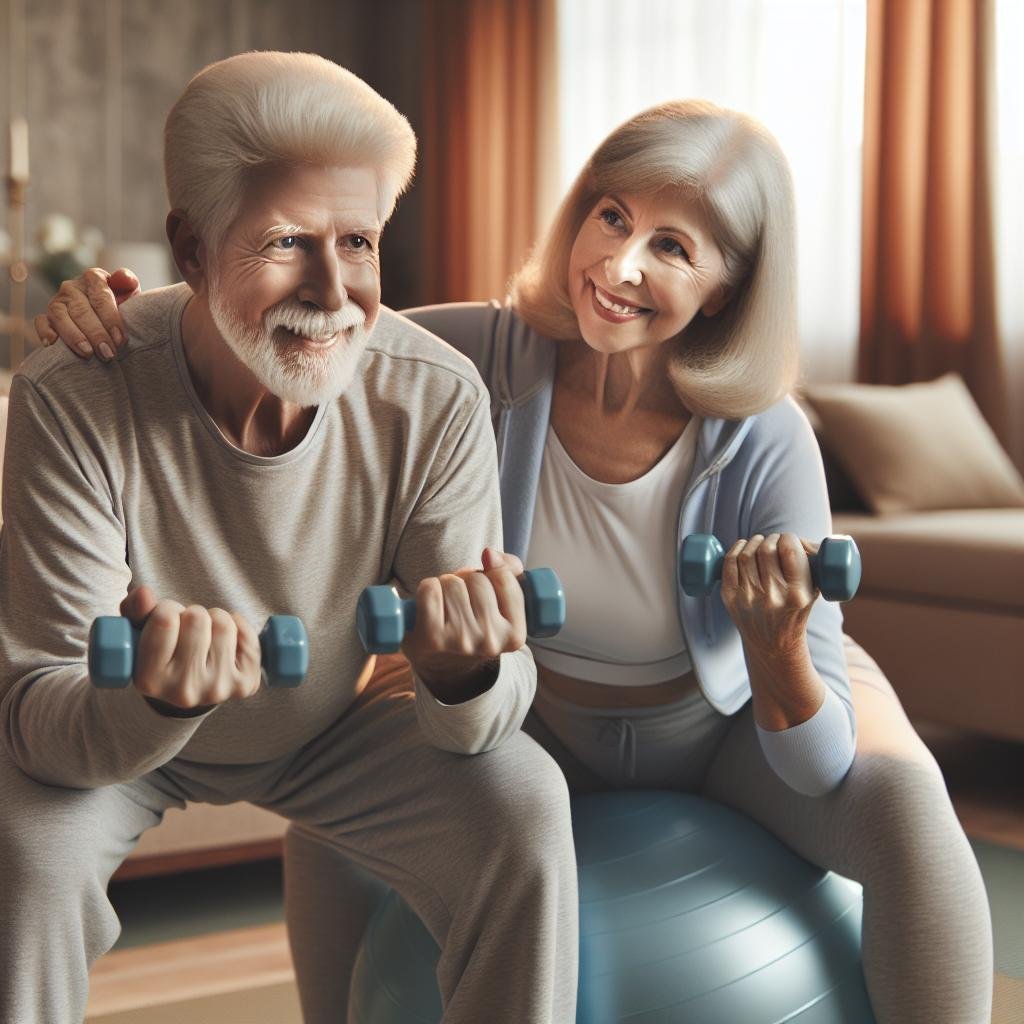
Best Home Workout Gear for Seniors | Expert Guide
Finding the right workout equipment can dramatically improve exercise safety and enjoyment for older adults. The best home workout gear for seniors combines stability, accessibility, and effectiveness without overwhelming complexity. This expert guide highlights specialized fitness equipment designed with seniors’ unique needs in mind, helping maintain independence and physical wellbeing.
Age shouldn’t limit your fitness journey. With proper equipment, seniors can build strength, improve balance, and enhance mobility right at home. Let’s explore the top fitness tools that support healthy aging while addressing common physical limitations.
Why Specialized Fitness Equipment Matters for Seniors
Standard fitness equipment often ignores older adults’ specific needs. Equipment designed with universal design principles makes exercise more accessible and safer for everyone, regardless of ability level.
According to geriatric fitness specialist Jennifer Tripken, Associate Director at the National Council on Aging, “The right equipment can make all the difference in maintaining an active lifestyle as we age. Equipment that offers stability, adjustability, and accommodates various physical limitations empowers seniors to exercise confidently.”
Regular physical activity helps seniors maintain independence, reduce fall risk, and manage chronic conditions. The National Institute on Aging recommends adults over 65 engage in both aerobic and strength activities weekly. The right equipment makes these goals attainable.
Top Home Fitness Equipment for Seniors
Stability-Focused Exercise Tools
Balance becomes increasingly important with age. These tools help seniors work on stability safely:
- Balance pads and discs: These cushioned surfaces create controlled instability, strengthening stabilizing muscles. The textured surface provides tactile feedback, while the soft material reduces injury risk if falls occur.
- Stability balls with base rings: Traditional exercise balls with added base rings prevent rolling when not in use. They improve core strength without requiring getting down on the floor.
- Yoga blocks and wedges: These props modify poses to accommodate limited flexibility or balance concerns. They bring the floor closer, reducing strain while maintaining proper alignment.
Physical therapist Maria Johnson recommends starting with simple balance exercises while holding onto a sturdy chair before progressing to balance tools. “Even small improvements in balance can significantly reduce fall risk,” she notes.
Resistance Training Equipment with Senior-Friendly Features
Maintaining muscle mass becomes crucial after 50, when we naturally begin losing 1-2% yearly. These resistance tools offer safe strength building options:
- Adjustable resistance bands with handles: These versatile tools feature comfortable grips and door anchors for easy setup. The color-coded resistance levels allow for gradual progression without intimidating weight numbers.
- Seated pedal exercisers: These compact machines enable arm or leg workouts while seated. Many models include LCD screens displaying time, calories, and resistance level, making progress tracking simple.
- Lightweight, soft dumbbells: These neoprene-coated weights reduce hand strain and damage risk if dropped. Starting with 1-3 pound weights allows safe form development before progression.
Robert Chen, a certified senior fitness instructor, emphasizes, “Resistance doesn’t need to be heavy to be effective. Consistent, proper form with lighter weights builds functional strength that translates to daily activities.”
Cardiovascular Equipment with Accessibility Features
Heart health remains vital throughout life. These machines make cardiovascular exercise more accessible:
- Recumbent bikes with step-through frames: The reclined seated position reduces stress on the back and knees while providing crucial back support. Wide, cushioned seats improve comfort during longer sessions.
- Treadmills with extended handrails: Senior-friendly models feature longer side rails for greater stability and emergency stop features. Lower maximum speeds focus on walking rather than running.
- Ellipticals with low step-in height: These machines provide effective low-impact workouts with minimal joint stress. Adjustable stride lengths accommodate different heights and mobility levels.
Dr. Susan Williams, a geriatric specialist, recommends starting with just 5-10 minutes of cardiovascular exercise daily. “Consistency matters more than duration initially. Building the habit leads to natural progression as endurance improves.”
Key Features to Look for in Senior Fitness Equipment
When selecting home workout gear for older adults, prioritize these important characteristics:
Safety Considerations
- Stability features: Wide bases, non-slip surfaces, and sturdy construction prevent tipping or sliding during use.
- Emergency stop mechanisms: Quick-stop features on powered equipment provide peace of mind during solo workouts.
- Smooth movement patterns: Equipment that guides natural motion reduces injury risk from improper form.
- Adjustable resistance: The ability to start with minimal resistance and gradually increase as strength improves prevents overexertion.
Accessibility Features
- Easy entry/exit design: Step-through frames and accessible heights reduce fall risk when mounting or dismounting equipment.
- Large, clear displays: High-contrast screens with simple interfaces accommodate vision changes common with aging.
- Comfortable seating: Ergonomic designs with proper lumbar support prevent discomfort during extended use.
- Simple setup and storage: Equipment that doesn’t require complex assembly or heavy lifting encourages regular use.
Adaptability Features
- Adjustable components: Equipment that accommodates different heights, weights, and mobility levels serves changing needs.
- Modifiable difficulty: The ability to increase or decrease challenge as fitness levels change extends equipment usefulness.
- Multi-function capabilities: Versatile equipment that works different muscle groups maximizes value and space efficiency.
Physical therapist Thomas Rivera suggests, “Equipment should meet you where you are today while allowing room for improvement tomorrow. Adaptability is key to long-term fitness success.”
Budget-Friendly Options That Don’t Sacrifice Safety
Quality senior fitness equipment doesn’t always require a significant investment. These affordable options provide excellent value:
Under $30
- Resistance bands sets: Complete kits include different resistance levels and attachments for full-body workouts. Look for bands with comfort grips and door anchors.
- Balance cushions: These inflatable discs improve stability during seated exercises or standing balance practice.
- Hand therapy balls: Different resistance levels strengthen grip and forearm muscles, crucial for daily activities like opening jars or carrying groceries.
$30-100 Range
- Adjustable ankle/wrist weights: These versatile weights attach securely with wide velcro straps and gradually adjust from 1-5 pounds.
- Pedal exercisers: Compact machines enable seated aerobic exercise for legs or arms. Basic models provide adjustable resistance without electronic features.
- Yoga starter kits: Senior-focused sets include wider mats, blocks, straps, and modified pose guides specifically addressing older adult needs.
$100-300 Investment Pieces
- Adjustable weight benches: Look for models with multiple incline positions and sturdy construction supporting at least 300 pounds.
- Folding treadmills: Space-saving walking treadmills with extended handrails provide safe indoor cardio options.
- Recumbent bikes: Entry-level models offer essential features like adjustable seats and basic resistance levels without costly electronics.
Fitness educator Patricia Morgan suggests, “Start with multipurpose basics and invest gradually as you identify your exercise preferences. Quality resistance bands and a stability ball provide numerous exercise options for under $50.”
Creating a Safe Home Workout Space for Seniors
Even the best equipment requires a properly prepared environment. Consider these factors when setting up your exercise area:
Space Requirements
- Minimum clearance: Allow at least 2 feet of clear space around all equipment for safe movement and emergency access.
- Flooring considerations: Non-slip surfaces reduce fall risk. Rubber mats provide joint-friendly cushioning and protect flooring.
- Temperature control: Maintain moderate temperatures (68-72°F) as seniors may be more sensitive to temperature extremes during exercise.
Safety Elements
- Proper lighting: Bright, even lighting without glare helps prevent trips and falls while allowing proper form observation.
- Stable support options: Place a sturdy chair or railing nearby for balance assistance during standing exercises.
- Emergency communication: Keep a phone within reach during workouts. Consider wearable emergency response systems for solo exercisers.
- Hydration station: Maintain a water bottle and small towel within easy reach to encourage proper hydration.
Organization Tips
- Visible storage: Open shelving keeps equipment visible and accessible, encouraging regular use.
- Equipment rotation: Keep frequently used items at waist height to avoid unnecessary bending or reaching.
- Visual reminders: Post exercise schedules or instruction sheets at eye level for quick reference.
Home safety specialist Michael Rodriguez advises, “The perfect workout space balances accessibility with safety. Remove trip hazards like cords or rugs, ensure good lighting, and keep emergency contacts visible.”
Getting Started: Building a Routine with Your New Equipment
Equipment alone doesn’t create results. These strategies help establish sustainable exercise habits:
Beginning Guidelines
- Medical clearance: Consult healthcare providers before starting any new exercise program, especially with pre-existing conditions.
- Start gradually: Begin with 5-10 minutes of activity, focusing on proper form rather than duration or intensity.
- Consistent schedule: Exercise at the same time daily to establish routine. Morning workouts often face fewer disruptions.
- Warm-up importance: Always begin with 5 minutes of gentle movement to prepare joints and muscles for activity.
Sample Starter Workouts
Seated Strength Circuit (15 minutes)
- Seated arm raises with light dumbbells: 8-10 repetitions
- Seated leg extensions: 8-10 repetitions each leg
- Seated chest press with resistance band: 8-10 repetitions
- Rest 1 minute, repeat circuit 2-3 times
Standing Balance Progression (10 minutes)
- Two-foot balance holding chair: 30 seconds
- One-foot balance holding chair: 15 seconds each side
- Two-foot balance without support: 30 seconds
- Progress to balance pad when confident
Cardiovascular Starter (10 minutes)
- 2 minutes slow warm-up pace
- 6 minutes moderate effort
- 2 minutes gradual cool-down
- Add 2 minutes weekly as endurance improves
Progress Tracking Methods
- Physical measurements: Track resting heart rate, walking distance, or exercise duration to monitor cardiovascular improvements.
- Strength indicators: Note resistance levels, repetitions completed, or time holding positions to measure strength gains.
- Functional assessments: Record improvements in daily activities like climbing stairs, carrying groceries, or standing from seated positions.
- Simple journaling: Keep a basic record of exercises completed, duration, and how you felt to identify patterns and progress.
Senior fitness specialist Angela Thompson recommends focusing on functional improvements rather than aesthetic changes. “Success means climbing stairs more easily or playing with grandchildren without fatigue—these meaningful metrics motivate continued effort.”
When to Consider Professional Guidance
While home exercise offers convenience, certain situations warrant professional assistance:
- Complex medical conditions: Conditions like recent heart events, uncontrolled diabetes, or severe arthritis require specialized exercise modification.
- Persistent pain: Pain lasting more than 48 hours after exercise needs professional evaluation to prevent injury.
- Balance concerns: Significant balance issues may require supervised training before independent home exercise.
- Motivation challenges: Difficulty maintaining consistent exercise may improve with professional accountability.
Consider these professional resources:
- Physical therapists: Develop personalized exercise programs addressing specific limitations or rehabilitation needs.
- Certified senior fitness specialists: Provide age-appropriate exercise guidance with specific senior certification.
- Virtual training: Online sessions with qualified professionals offer convenience with professional oversight.
Dr. James Chen, rehabilitation specialist, notes, “Even a few sessions with a qualified professional can provide a solid foundation for safe, effective home exercise. Consider it an investment in proper technique rather than an ongoing expense.”
Conclusion: Empowering Independence Through Appropriate Equipment
The right fitness equipment removes barriers to physical activity for seniors, supporting independence and quality of life. By prioritizing safety, accessibility, and proper technique, older adults can enjoy the numerous benefits of regular exercise from the comfort and convenience of home.
Remember that consistency trumps intensity. Small, regular efforts build into significant improvements over time. Begin with equipment that addresses your specific needs and interests, creating a foundation for sustainable fitness habits.
Have you found particular fitness equipment especially helpful in your home workout routine? Share your experiences to help others find their perfect fitness tools for healthy aging.
References
- National Institute on Aging – Exercise and Physical Activity
- National Council on Aging – Physical Activity Programs
- American Physical Therapy Association – Physical Activity for Healthy Aging
- CDC – Physical Activity for Older Adults
- American Council on Exercise – Functional Training for Older Adults


